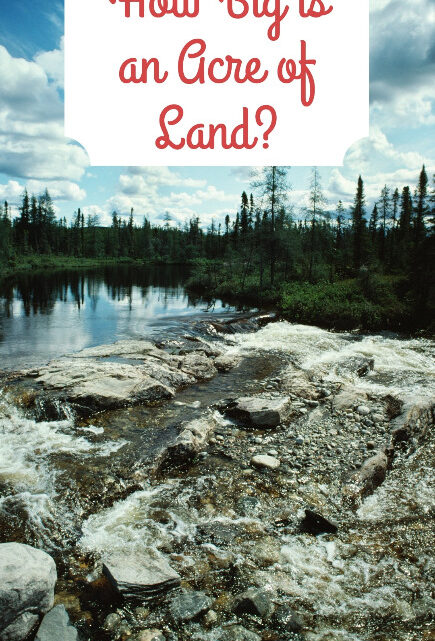An acre of land is a standard measurement used in the United States to determine the size of properties. It is equivalent to 43,560 square feet and has no specific shape.
Understanding the size of an acre is essential in various fields, such as agriculture, real estate, and land development.
We will explore the history, measurements, and practical uses of an acre of land. Additionally, we will discuss different types of acres and the cost of land per acre. You’ll also see helpful conversion tools for better understanding land measurements.
Determining the property’s square footage will be essential if you buy land in Massachusetts.
What is an Acre of Land?
From experience working as a Realtor, one of the questions buyers ask is, “How big is an acre?”
Understanding the concept of an acre is essential for anyone buying, selling, or managing land.
An acre is defined as 43,560 square feet but has no specific shape. Instead, it represents a particular land area, regardless of its dimensions. The exact size of an acre can vary based on its length and width as long as the total area equals 43,560 square feet. This flexibility allows for versatility in land use and ensures consistency in measurement.
The origin of the acreage measurement can be traced back to medieval England in the 13th century. In those times, an acre represented the amount of land a team of oxen could plow in one day.
A specific configuration was established to standardize the measurement: 4 poles wide (also known as rods or perches) by 40 poles long. Each pole measured 16.5 feet, resulting in an acre measuring 66 feet wide and 660 feet long.
Today, understanding the size of an acre is crucial. It’s especially true when estimating land value, planning development projects, or determining property boundaries.
Whether you’re a farmer looking to assess crop yields, a real estate agent evaluating land for sale, or a homeowner considering land for building, knowing the size of an acre allows for informed decision-making.
Understanding what an acre represents will help you make more informed choices and effectively communicate with professionals in various industries.
The History and Origins of the Acre Measurement
The acre measurement has a rich history that dates back to the 13th century in England. It originated as a practical unit of measurement for agricultural purposes. It was precisely the amount of land a pair of oxen could plow in one day. The need to standardize this measurement led to establishing the acre as a defined unit of land.
Initially, an acre was defined as a plot of land 4 rods wide (1 rod equivalent to 16.5 feet) and 40 rods long. This resulted in an acre of land measuring 66 feet by 660 feet. Over time, this measurement system spread to other regions, including the United States, where it is still commonly used today.
It is interesting to note that the dimensions of an acre were based on the practical limitations of agricultural equipment at the time. The width of 66 feet was chosen to allow for efficient plowing with a pair of oxen. The length of 660 feet was based on the distance the oxen could successfully plow in a day’s work.
As the agricultural society evolved and modernized, the acre measurement was adapted for various land uses beyond farming. It became a widely accepted unit for measuring real estate properties, both residential and commercial, as well as for land development and land use planning purposes.
Today, the acre measurement remains relevant in the United States. It is a fundamental unit for measuring land area, with its historical origins deeply rooted in the practicality and efficiency of traditional agricultural practices.
Comparing an Acre to a Football Field
When trying to visualize the size of an acre, it can be helpful to compare objects or spaces that we are more familiar with. One standard comparison is to a football field. However, it is essential to note that an acre does not equal an entire football field.
Instead, an acre is approximately 75% the size of a football field.
A standard American football field measures about 360 feet in length and 160 feet in width, including the end zones. This adds up to a total playing area of 57,600 square feet. Comparing this to the size of an acre, which is 43,560 square feet, we can see that an acre is slightly smaller than a football field.
To give you a better idea, if you were to imagine covering 75% of a football field with an imaginary rectangle, that rectangular area would roughly represent the size of an acre. So, while an acre is not precisely the same as a football field, it provides a valuable reference point to understand its scope.
Remember that a football field is just one of many comparisons used to grasp the concept of an acre. It is always a good idea to consult accurate measurements and visual aids to fully understand the size of an acre, especially if you are considering purchasing or developing land.
Now that we have a better understanding of the size of an acre and how it relates to a football field, let’s explore different types of acres and their applications in various industries.
Different Types of Acres: Commercial and Residential
When discussing acres of land, it’s important to note that there are different types of acres, mainly commercial and residential. These distinctions are often relevant in the real estate industry and can impact a property’s potential use and value.
Commercial Acres
A commercial acre refers to land designated for commercial purposes, such as retail spaces, office buildings, or industrial facilities. These acres are typically located in commercial zones or areas designated for business activities.
- Commercial acres are sought after by investors and developers looking to build commercial properties and generate revenue through leasing or selling commercial spaces.
- They are often strategically located in bustling urban or suburban areas or near major transportation hubs to attract customers and facilitate business operations.
- Commercial acres tend to be larger than residential ones. They often require more space to accommodate the construction of large buildings and parking lots.
Residential Acres
On the other hand, residential acres are primarily intended for housing purposes. This category includes land where people can construct single-family homes, apartment complexes, or planned residential developments.
- Residential acres are common in residential neighborhoods or suburbs, providing space for individuals and families to build homes.
- They come in various sizes and shapes, ranging from small plots of land for single-family homes to larger parcels for multi-unit housing projects.
- Residential acres often have specific zoning regulations dictating the type of housing that can be built on the land. It ensures that the area remains suitable for residential living. When zoning allows for smaller lots, builders can construct more affordable housing.
Understanding the distinction between commercial and residential acres is essential for buyers and sellers in the real estate market. It allows them to identify properties that align with their specific needs and goals, whether establishing a thriving business or creating a comfortable home.
The Usefulness of an Acre Measurement in Real Estate
Measuring an acre is crucial in assessing property value and determining land use in the real estate industry. Understanding the size of an acre allows real estate professionals, developers, and buyers to make informed decisions and accurately evaluate properties.
Here are some key points highlighting the usefulness of an acre measurement in real estate:
- Property Evaluation: The acre measurement provides a standardized unit for comparing and evaluating property sizes. Whether it’s a residential, commercial, or agricultural property, knowing the acreage helps determine its potential uses and overall value.
- Land Development: Massachusetts developers rely on the acre measurement to assess the feasibility of various projects. Understanding the available acreage allows them to plan and design subdivisions, retail centers, or other developments that optimize land use.
- Construction: An acre measurement is valuable in estimating the land size needed to construct residential buildings. It aids in determining the right amount of space for homes, driveways, yards, and other amenities while adhering to building regulations and zoning requirements. Mortgage lenders also want to know the land size when providing a construction loan.
- Land Use Planning: Government agencies and urban planners utilize acre measurements to formulate land use plans and zoning regulations. This data helps preserve open spaces and designate areas for specific purposes like parks, schools, or commercial districts. It also helps ensure efficient land allocation within communities.
- Market Analysis: Real estate professionals and analysts utilize acre measurements to study market trends and assess property values. By examining the price per acre in specific locations, they can identify investment opportunities, understand market dynamics, and make informed recommendations to buyers and sellers.
The acre measurement is a common language in the real estate industry. It facilitates communication and provides a standardized basis for negotiations and transactions.
How Much Does an Acre of Land Cost?
One of the most important factors when purchasing land in Massachusetts is the cost per acre. The price of an acre of land can vary depending on several factors. Location, accessibility, zoning regulations, and market demand are crucial in land valuation.
While providing an exact figure is challenging, we can explore some general trends and estimates as land prices fluctuate constantly.
Location is Crucial in Massachusetts Land Prices
Land prices can vary significantly based on the location. The cost per acre tends to be higher due to high demand and limited supply in highly sought-after urban centers, coastal regions, or prime agricultural regions.
On the other hand, rural or remote areas may offer more affordable land options.
- Urban Centers: In densely populated cities or towns, where land is scarce, the cost per acre can range from hundreds of thousands to millions of dollars.
- Coastal Regions: Land near the coast, with picturesque views or beach access, tends to be highly desirable and can command a premium price tag.
- Prime Agricultural Regions: Fertile agricultural land, suitable for farming or ranching, is often valued higher than other types of land.
- Rural Areas: In less populated or remote regions, the cost per acre may be more affordable, with prices ranging from several thousand to tens of thousands of dollars.
Accessibility With Land in Massachusetts
The accessibility of the land can also impact its price. Land that is easily accessible, with good road connectivity and proximity to amenities such as schools, hospitals, and shopping centers, may be priced higher than land that is difficult to access.
Massachusetts Land Zoning Matters
Zoning regulations imposed by local authorities can influence acreage costs. Land zoned for commercial or residential development tends to be more expensive than land zoned for agricultural or recreational use.
Market Demand For Land in Massachusetts
The overall demand for land in a particular area can significantly affect its price. The cost per acre is likely to rise if there is a high demand for land due to population growth, economic development, or infrastructure projects.
It’s important to note that the cost of an acre of land is just one aspect of the overall investment. Additional expenses may include surveying, soil testing, legal fees, and potential development costs.
Consulting with a real estate professional or land surveyor can provide a more accurate estimate of the total land cost.
Ultimately, the cost of an acre of land can vary significantly depending on location, accessibility, zoning, and market conditions.
To determine the right price for the land you are interested in, you must conduct thorough research, consult experts, and consider your specific needs and budget.
Factors Affecting the Cost of an Acre in Massachusetts
Several factors come into play when determining the cost of an acre of land. These factors can significantly impact the price and vary depending on the location and intended use of the land.
Here are some key considerations:
- Location: Land prices are heavily influenced by location. Acreage in highly desirable areas, such as prime urban or coastal locations, tends to command a higher price than rural or less sought-after regions. Proximity to amenities, infrastructure, and economic centers can significantly affect the cost.
- Land Use Zoning: The designated use of the land, as determined by local zoning regulations, plays a crucial role in pricing. Zoning classifications can range from residential to commercial, agricultural, industrial, or mixed-use. Specific zoning categories may carry higher value due to their development potential or restrictions on land use.
- Topography and Terrain: The physical characteristics of the land, such as its slope, elevation, accessibility, and natural features, can influence its value. Flat, level ground is often preferred for easy development. Land may be priced higher than hilly or irregularly shaped parcels that require extra preparation.
- Utilities and Infrastructure: Availability and proximity to essential utilities like water, electricity, sewer systems, and paved roads can impact the value of an acre. Access to established infrastructure can reduce development costs and increase desirability, leading to a higher price. Many rural and suburban areas have septic systems, which can be expensive.
- Market Conditions: Land prices are subject to market forces like any commodity. Supply and demand dynamics, economic trends, interest rates, and the overall real estate market conditions can influence the asking price of an acre. In a competitive market with high demand, prices may rise accordingly.
- Development Potential: The potential for future development or land use can increase the value of an acre in Massachusetts. Factors such as proximity to growing areas, demographic trends, and changes in local land use policies and regulations can all impact the land’s perceived value and subsequent price.
- Environmental Factors: Environmental considerations may affect the cost of an acre. Conservation restrictions, protected habitats, or contamination issues can decrease the value of specific properties. On the other hand, environmentally friendly and sustainable features, like access to clean water sources or renewable energy resources, can add value.
It’s important to note that these factors are not exhaustive, and individual circumstances may introduce additional variables when determining the cost of an acre of land.
Consulting with local Realtors, appraisers, or land use experts can provide specific insights and guidance based on your unique situation and location.
Understanding Land Measurements in Other Regions
Regarding land measurements, it’s essential to understand that different regions may have unique systems and measurement units. While an acre is a commonly used measurement in the United States, other countries may have their equivalents or different standards for land measurement.
In the United Kingdom, for example, the acre is defined as 4,840 square yards, slightly different from the American acre. This can lead to confusion when dealing with international land measurements or comparing properties across borders.
Similarly, in some European countries, land measurements are based on the metric system, such as square meters or hectares. These units provide a different scale for measuring the size of a piece of land.
Converting between acres and square meters can be helpful when dealing with international real estate transactions or assessing land sizes in metric-based countries.
Besides regional differences, it’s essential to consider local regulations and zoning ordinances when dealing with land measurements.
Local authorities may have specific requirements regarding minimum lot sizes, setback distances, and building restrictions. These regulations can impact the use and development potential of the land. They can also influence the maximum size of structures built on a particular parcel.
Consulting Land Experts is Wise
When evaluating land measurements in different regions, consulting with local experts, such as real estate agents, land surveyors, or legal professionals familiar with the specific area’s regulations and practices, is essential.
These experts can provide guidance and ensure an accurate understanding of land measurements and their implications.
- Consider local regulations and zoning ordinances.
- Consult with local experts familiar with the area.
- Understand regional differences in land measurement units.
- Be aware of conversion factors between different land measurement systems.
Conversion Tools: Acre to Square Meters and More
When understanding land measurements, having conversion tools at your disposal can be helpful. These tools allow you to easily convert between different units of measurement, such as acres to square meters.
If you are relocating in or out of Massachusetts, you may want to know how big an acre is under a different measuring system.
Let’s explore some of the standard conversion tools available:
Acre to Square Meters:
- To convert an acre to square meters, you can use the following conversion factor: 1 acre = 4046.86 square meters.
- For example, if you have 3 acres of land, you can multiply it by 4046.86 to determine that it equals 12,140.58 square meters.
An Acre to Square Feet:
- For those who prefer using square feet as a unit of measurement, you might need to convert acres to square feet. One acre is equivalent to 43,560 square feet.
- So, if you have 0.5 acres of land, you can multiply it by 43,560 to find that it equals 21,780 square feet.
Acre to Hectares:
- Converting acres to hectares might be necessary if you are dealing with international measurements. One acre is equal to 0.4047 hectares.
- For instance, if you have 10 acres of land, you can multiply it by 0.4047 to find that it equals 4.047 hectares.
Acre to Square Kilometers:
- Converting acres to square kilometers might be more convenient when dealing with larger areas. One acre is equivalent to 0.004047 square kilometers.
- So, if you have 100 acres of land, you can multiply it by 0.004047 to find that it equals 0.4047 square kilometers.
Other Unit Conversions:
- In addition to the abovementioned conversions, plenty of other unit conversions are available. You can convert acres to square miles, square yards, square inches, and more.
- Each unit of measurement has its conversion factor, which you can easily find using online conversion tools or reference tables.
With these conversion tools, you can quickly and accurately convert acres to various other units of measurement.
Whether you’re working in the real estate industry, agriculture, or simply curious about land sizes, these tools will help you quickly navigate the world of land measurements.
Tips for Buying or Selling Land by the Acre
You must consider several essential factors when buying or selling land by the acre. Whether you’re a buyer looking for the perfect piece of land or a seller hoping to get the best price, these tips can help guide you through the process.
- 1. Do your research: Before entering into any land transaction, it’s crucial to gather as much information as possible. Research local zoning laws, environmental regulations, and any future development plans that may impact the value or potential use of the land.
- 2. Determine the purpose: Consider the intended use of the land. Are you looking for agricultural land, residential development, or commercial purposes? Understanding the goal will help you assess the value and potential profitability of the acreage.
- 3. Get a professional appraisal: Hiring a qualified appraiser can provide an accurate assessment of the land’s value, considering factors such as location, accessibility, topography, and potential for development.
- 4. Consider infrastructure: Access to utilities, roads, and other necessary infrastructure can significantly impact the value and usability of the land. Analyze the existing infrastructure and potential costs for essential improvements or connections.
- 5. Engage an experienced real estate agent: Working with a knowledgeable Massachusetts agent specializing in land sales can be invaluable. They can assist in finding potential buyers or sellers, navigating legal requirements, and negotiating favorable terms.
- 6. Understand financing options: If purchasing land, explore different financing options, including traditional mortgages, land loans, or owner financing. Understanding the financing landscape can help you make an informed decision.
- 7. Conduct a thorough title search: Before finalizing any land transaction, ensure a comprehensive title search is conducted to identify any liens, encumbrances, or legal issues that may affect the property’s ownership or value.
- 8. Consider future growth potential: Evaluate the potential for future growth and development in the area. Factors such as population growth, expanding infrastructure, and nearby amenities can influence the long-term appreciation and desirability of the land.
- 9. Consult with professionals: Seek advice from professionals such as real estate attorneys, surveyors, and environmental experts to ensure compliance with legal requirements, accurate boundary delineation, and assessment of any potential environmental concerns.
- 10. Negotiate favorable terms: Whether buying or selling, negotiate good terms, such as price, contingencies, closing dates, and any additional considerations specific to the transaction. Working with a skilled negotiator can help you achieve your goals.
Understanding Property Boundaries and Privacy
When owning land, understanding property boundaries and ensuring privacy is crucial. Property boundaries define the limits of your plot and help establish where your land ends and your neighbor’s begins.
It is essential to clearly understand these boundaries to avoid disputes and maintain your privacy.
Here are some key points to consider regarding property boundaries and privacy:
Critical Considerations For Massachusetts Land Buyers
- Survey or Plat Map: A survey or plat map is a detailed document that outlines your property’s exact measurements and dimensions. It visually represents your land boundaries, including markers and reference points.
- Hiring a Professional Surveyor: If you are unsure about your property boundaries, it is advisable to hire a professional surveyor. They will conduct a thorough survey of your land, identify markers, and provide you with an accurate assessment of your property lines.
- Boundary Disputes: In some cases, boundary disputes may occur. It’s common if neighboring landowners have conflicting understandings or claims about the property boundaries. Addressing such conflicts promptly and amicably is crucial, often involving legal experts or mediators to resolve the issue.
- Privacy Considerations: Property boundaries play a significant role in maintaining privacy. A well-defined boundary helps prevent encroachment from neighbors and uninvited access to your land. Installing fences, hedges, or other physical barriers can further enhance privacy and security.
- Easements and Right-of-Ways: You grant someone a legal right to use a specific portion of your land for a particular purpose. An example would be accessing a public road. Awareness of existing easements or right-of-ways on your property is essential, as they can impact your land use and privacy.
- Local Zoning Regulations: Understanding local zoning regulations regarding property boundaries and privacy is crucial. These regulations govern the type of structures you can build, setback requirements, and other factors that may impact your land use and privacy.
By clearly understanding your property boundaries and taking steps to maintain your privacy, you can enjoy the full benefits of your land ownership while respecting your neighbors’ rights.
Final Thoughts
There you have it. You should better understand an acre’s size when looking for land to purchase in Massachusetts.










No Comment